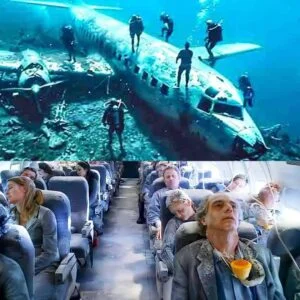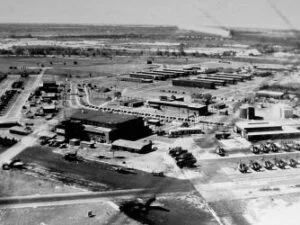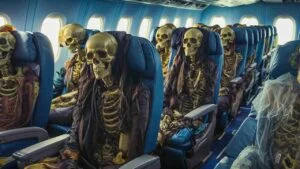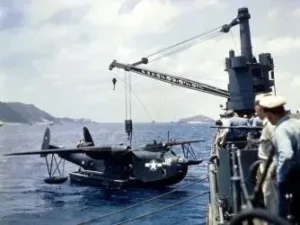For decades, the frightening secrets of flight 19 have stimulated speculation, conspiracy theories and even supernatural explanations.
How could five highly trained pilots, a flying well maintained aircraft on a routine mission, disappear without a trace? Was it just a human mistake and bad weather, or did something much more sinister play?
Some believe that the unknown force may have interfered with their navigation systems, while others claim that they have become the victims of the infamous Bermuda Triangle. When you immerse yourself in this cooling story, prepare for everything you thought you knew about aviation, history and unexplained.
It all started as a regular training flight. December 5, 1945 at 14:10, five TBM Avenger aircraft took off from the naval air station in FT. Lauderdale, Florida …

Witnessed an amazing discovery
What began as a routine training mission soon became one of the most modern aerial mysteries in history. December 5, 1945, exactly at 14:10, five TBM Avenger aircraft left Fort Lauderdale, Florida. Squadron, known as “Flight 19”, was scheduled to complete a three -hour training exercise called “Navigation problem number one”.
Their flight journey was direct: to fly east of Florida, a bombs in a training place known as Hens and Chickens Shoals, turn north via Grand Baham Island, and then go to the southwest to return to the base. Each aircraft carried three and pilots had an average of 300 flights. The head of the mission was Lieutenant Charles C. Taylor, a seasoned pilot and veteran from World War II.
Turn to a worse
Initially the exercise continued without a problem. Flight 19 successfully dropped from practical bombs to the target at Hens and Chickens Shoals around 14:30. But when they turned north to continue their route, there were problems. Lieutenant Taylor suspected that his aircraft did not work and feared they were flying from the course. Things escalated when a sudden storm brought strong winds, heavy rain and a thick cloud cover. Disorientated, one of the pilots in need commented: “I don’t know where we are. After the last turn we had to get lost. ”

Errors of confusion and navigation
Lieutenant Robert F. Cox, a navy flight instructor located near the coast of Florida, heard flight gearboxes 19. When he realized the urgency of the situation, he immediately pointed out the base and tried to help Taylor. Taylor replied and said, “Both of my compasses are out and try to find Fort Lauderdale in Florida. I see the ground, but it’s fragmented. I think I’m over Florida Keys, but I don’t know how far south. ”
This statement was confused by those who listened. Less than an hour earlier flew through the Bahamas. If Taylor’s faith was correct, it meant that they somehow turned hundreds of kilometers from the course. Some speculate that his recent transfer from Miami to Fort Lauderdale may have led him to the mistake of the Baham Islands behind Florida Keys.
In the case of disorientation above the Atlantic, the standard protocol instructed pilots to head to the west to the setting sun to locate the mainland. But Taylor was convinced that they were over the Gulf of Mexico. In a critical mistake, he ordered his pilots to fly to the northeast – dispensively led them to the open ocean.
Some other pilots seemed to recognize this mistake. The frustration mounted and there was one voice over the radio: “Dammit, if we just flew to the west, we would get home.” Despite these concerns, pilots eventually followed Taylor’s commands and sealed their fate.

The last moments
At one point, Taylor briefly agreed to turn to the west, but soon changed his mind. “We didn’t go far enough east,” insisted. “We could also return.” Some reports indicate that one of the aircraft might have had a defiance of broken formations, but most of the squadrons followed Taylor’s orders.
When the aircraft moved further into the ocean, their radio signals weakened. Thanks to the reduction of fuel, Taylor prepared the crew for emergency landing. “All aircraft are tight,” he ordered. “We’ll have to let go when the first aircraft is out of the fuel.” We all go together. “A moment later the radio contact was lost and the 19th 19 disappeared.
A Rescue Mission Ends in Another Tragedy
The Navy launched an immediate search operation. Around 7:30 p.m., two PBM Mariner seaplanes took off from a nearby base to locate the missing aircraft. Within just 20 minutes, however, one of the rescue planes also vanished from radar, never to be seen again.
It is widely believed that the Mariner exploded shortly after takeoff. These flying boats had a reputation for being highly flammable, earning them the nickname “flying gas tanks.” Supporting this theory, a passing merchant ship reported seeing a fiery explosion and an oil slick in the water.
A Mystery That Endures
The following morning, an extensive search operation was launched. More than 300 aircraft and ships scoured over 300,000 square miles of ocean and land for five days. Despite their efforts, no wreckage, bodies, or clues were ever recovered.
A Navy investigation ruled that a compass malfunction may have caused confusion, but it could not fully explain why the planes became so disoriented. The official report attributed the incident to “causes or reasons unknown.”

The enigma surrounding Flight 19 has fueled countless theories. In the 1960s and 1970s, authors Vincent Gaddis and Charles Berlitz popularized the idea that the planes fell victim to the infamous “Bermuda Triangle,” a region notorious for unexplained disappearances. Speculative explanations range from unusual magnetic forces to alien abductions. The 1977 film Close Encounters of the Third Kind even depicted Flight 19 as having been abducted by extraterrestrials and later returned to Earth.
Curiously, some strange details emerged in the investigation. Witnesses reported that Lieutenant Taylor had arrived late for the pre-flight briefing and seemed reluctant to take part in the mission, though his reasons remain unclear. Additionally, none of the pilots used the emergency rescue radio frequency or activated their ZBX receivers, which could have helped them locate Navy radio signals.
The most plausible theory is that Flight 19 simply ran out of fuel and crashed into the Atlantic. In 1991, researchers discovered the remains of World War II-era aircraft off the coast of Fort Lauderdale, but these were later identified as belonging to a different squadron.
To this day, the final resting place of Flight 19 and the missing rescue plane remains a mystery, adding yet another chapter to the eerie legend of the Bermuda Triangle.
Conclusion
The disappearance of Flight 19 remains one of the greatest aviation mysteries of all time. Despite extensive search efforts and countless investigations, no definitive evidence has ever been found to explain what truly happened that fateful day. While mechanical failure, human error, and fuel exhaustion are the most plausible explanations, the lack of physical evidence has allowed myths and conspiracy theories to thrive.
From tales of the Bermuda Triangle’s strange forces to theories of alien abduction, the mystery continues to capture the imagination of historians, aviation experts, and enthusiasts alike. Until the wreckage is discovered, Flight 19 will remain a haunting reminder of the dangers of navigation, the vastness of the ocean, and the enduring power of the unknown.



